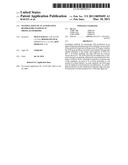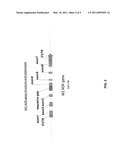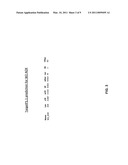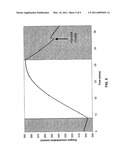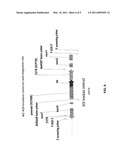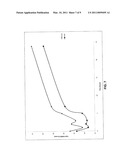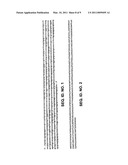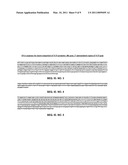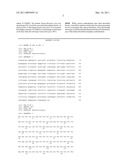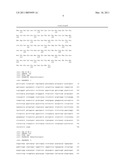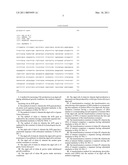Patent application title: MANIPULATION OF AN ALTERNATIVE RESPIRATORY PATHWAY IN PHOTO-AUTOTROPHS
Inventors:
Shaun Bailey (Los Altos, CA, US)
Bertrand Vick (Emeryville, CA, US)
Jeff Moseley
IPC8 Class: AC12P764FI
USPC Class:
435134
Class name: Micro-organism, tissue cell culture or enzyme using process to synthesize a desired chemical compound or composition preparing oxygen-containing organic compound fat; fatty oil; ester-type wax; higher fatty acid (i.e., having at least seven carbon atoms in an unbroken chain bound to a carboxyl group); oxidized oil or fat
Publication date: 2011-03-10
Patent application number: 20110059495
Claims:
1. A method for increasing TAG production in an algal cell during
imbalanced growth conditions, the method comprising:knocking out an AOX
gene.
2. The method of claim 1, wherein the AOX gene produces an amino acid sequence having substantial similarity to the amino acid sequence of SEQ. ID. NO. 2.
3. The method of claim 1, wherein the algal cell is of genus Nannochloropsis.
4. The method of claim 1, wherein the AOX gene is replaced by the construct having a nucleotide sequence having substantial similarity to SEQ ID. NOS. 3-5.
5. The method of claim 4, wherein the AOX gene is replaced by the construct of claim 4 via homologous recombination.
6. The algal cell of claim 1, wherein the AOX gene has a nucleotide sequence with substantial similarity to SEQ ID. NO. 1.
7. The algal cell of claim 4, wherein the algal cell is grown in presence of an antibiotic in which the algal cell is resistant.
8. The algal cell of claim 4, wherein the marker gene confers resistance to zeocine.
9. The algal cell of claim 4, wherein the algal cell is of genus Nannochloropsis.
10. The algal cell of claim 4, grown under imbalanced growth conditions.
11. The algal cell of claim 10, grown under starvation conditions.
12. The algal cell of claim 4, wherein lipid production is increased over that produced by a wild-type Nannochloropsis algal cell.
13. A transformation construct, the transformation construct having a first sequence of DNA similar to a corresponding first sequence of nuclear DNA of an algal cell, the transformation construct having a second sequence of DNA similar to a corresponding second sequence of nuclear DNA of the algal cell, and the transformation construct having a sequence of DNA of interest inserted between the first and second sequences of the transformation construct.
14. The transformation construct of claim 13, wherein the DNA of interest comprises a sequence having substantial similarity to SEQ. ID. NO. 3.
15. The transformation construct of claim 13, wherein the DNA of interest comprises a sequence having substantial similarity to SEQ. ID. NO. 4.
16. The transformation construct of claim 13, wherein the DNA of interest comprises a sequence having substantial similarity to SEQ. ID. NO. 5.
17. The transformation construct of claim 14, wherein the DNA of interest further comprises a sequence having substantial similarity to SEQ. ID. NO. 4.
18. The transformation construct of claim 17, wherein the DNA of interest comprises a sequence having substantial similarity to SEQ. ID. NO. 5.
19. A transformation method for introducing deoxyribonucleic acid (DNA) into the nucleus of an algal cell, the method comprising:preparing a transformation construct, the transformation construct having a first sequence of DNA similar to a corresponding first sequence of nuclear DNA, the transformation construct having a second sequence of DNA similar to a corresponding second sequence of the nuclear DNA, the transformation construct having a sequence of DNA of interest inserted between the first and second sequences of DNA of the transformation construct, andtransforming a target sequence of DNA inserted between the first and second corresponding sequences of the nuclear DNA, resulting in replacement of the target sequence of DNA with the sequence of DNA of interest, wherein the target sequence has substantial similarity to SEQ. ID. NO. 1.
Description:
CROSS-REFERENCE TO RELATED APPLICATIONS
[0001]The present application claims the benefit and priority of U.S. Provisional Patent Application Ser. No. 61/227,026 filed on Jul. 20, 2009, titled Manipulation of an Alternative Respiratory Pathway in Photo-Autotrophs, the disclosure of which is hereby incorporated by reference.
[0002]The present application is related to U.S. Non-Provisional patent application Ser. No. 12/581,812 filed on Oct. 19, 2009, titled "Homologous Recombination in an Algal Nuclear Genome," which is hereby incorporated by reference.
[0003]The present application is related to U.S. Non-Provisional patent application Ser. No. 12/480,635 filed on Jun. 8, 2009, titled "VCP-Based Vectors for Algal Cell Transformation," which is hereby incorporated by reference.
[0004]The present application is related to U.S. Non-Provisional patent application Ser. No. 12/480,611 filed on Jun. 8, 2009, titled "Transformation of Algal Cells," which is hereby incorporated by reference.
REFERENCE TO SEQUENCE LISTINGS
[0005]The present application is filed with sequence listing(s) attached hereto and incorporated by reference.
BACKGROUND OF THE INVENTION
Field of the Invention
[0006]This invention relates to molecular biology, and more specifically, to the expression of exogenous DNA elements in algal cells and/or the mutation of algal cells.
SUMMARY OF THE INVENTION
[0007]Exemplary methods for increasing TAG production in an algal cell during imbalanced growth conditions are provided. Some methods comprise knocking out an AOX gene, wherein the AOX gene produces an amino acid sequence having substantial similarity to the amino acid sequence of SEQ. ID. NO. 2. In further methods, the algal cell may be of genus Nannochloropsis. The AOX gene may be replaced by a construct having a nucleotide sequence having substantial similarity to SEQ ID. NOS. 3 through 5 (inclusive), wherein each of the sequences are next to or in close proximity to one another in a linear fashion. In some methods, the AOX gene may be replaced via homologous recombination. Further, the AOX gene may have a nucleotide sequence with substantial similarity to SEQ ID. NO. 1. Additionally, the recombinant algal cell may be grown in the presence of an antibiotic in which the selected recombinant algal cell is resistant. A marker gene may confer resistance to zeocine. As a result, lipid production by the selected recombinant algal cell may be increased over that produced by a wild-type algal cell.
BRIEF DESCRIPTION OF THE DRAWINGS
[0008]FIG. 1 shows an exemplary CLUSTALW alignment for three amino acids produced by various AOX genes, as found in three different types of algae.
[0009]FIG. 2 shows an exemplary gene structure and expression diagram for the wild-type Nannochloropsis (W2) AOX gene sequence, as found in the Nannochloropsis genome.
[0010]FIG. 3 shows exemplary TargetP1.1 prediction data for the wild-type Nannochloropsis (W2) AOX gene sequence.
[0011]FIG. 4 shows a chart reflecting exemplary expression levels of the wild-type Nannochloropsis (W2) AOX gene sequence in the presence and absence of nutrients, labeled as (Nutrients+) and (Nutrients-), respectively.
[0012]FIG. 5 shows a chart reflecting exemplary environmental oxygen concentrations in the presence of wild-type Nannochloropsis under varying light conditions over time.
[0013]FIG. 6 shows an exemplary W2 AOX knockout construct and integration site.
[0014]FIG. 7 shows a chart with actual exemplary data comparing the accumulation of fatty acid methyl esters (FAMES) during nutrient starvation of wild-type Nannochloropsis (WT) and mutant Nannochloropsis (A11).
[0015]SEQ. ID. NO. 1 is an exemplary nucleotide sequence for the AOX gene sequence.
[0016]SEQ. ID. NO. 2 is an exemplary amino acid sequence for the amino acid produced by SEQ. ID. NO. 1.
[0017]SEQ. ID. NO. 3 is an exemplary nucleotide sequence for a VCP promoter gene.
[0018]SEQ. ID. NO. 4 is an exemplary nucleotide sequence for a ble marker gene (confers resistance to zeocine).
[0019]SEQ. ID. NO. 5 is an exemplary nucleotide sequence for a 3' UTR gene.
DETAILED DESCRIPTION OF THE INVENTION
[0020]Whole chain electron transport in mitochondrial respiration typically involves four major protein complexes located in the inner mitochondrial membrane. During respiratory electron flow through these four complexes, electron donors, such as nicotinamide adenine dinucleotide phosphate (NADP), and succinate, become oxidized, while molecular oxygen ultimately becomes reduced by the terminal protein complex in the pathway known as cytochrome c oxidase. Respiratory electron flow is coupled to proton pumping across the mitochondrial inner membrane, generating a significant proton motive force (PMF). The PMF is subsequently released through the adenosine triphosphate (ATP) synthase, leading to the generation of energy rich molecular ATP.
[0021]A second form of respiratory electron flow, known as the alternative respiratory pathway, employs an oxidase known as the alternative oxidase (AOX), which is generally located upstream to the cytochrome c oxidase in the respiratory pathway. The alternative respiratory pathway terminates electron flow with the reduction of molecular oxygen upstream of complex III, therefore bypassing this complex as well as the terminal cytochrome c oxidase. Since complex III and the cytochrome c oxidase pump protons during electron transport, alternative respiration leads to the formation of significantly less ATP per electron donor oxidized, relative to whole chain respiration. In this respect, alternative respiration is a wasteful process in terms of maximizing energy conversion from cellular reductant. For oxygenic photo-autotrophs, it may be necessary to employ such a wasteful pathway during imbalanced growth, when more reduced carbon is generated through photosynthesis than can be used for growth and cell division. Examples of imbalanced growth include excessive irradiance and low nutrient status. The accumulation of excess reduced carbon during imbalanced growth may also be alleviated through the generation of triacylglycerides (TAGs).
[0022]According to various exemplary embodiments herein, the loss of reductant through an alternative respiratory pathway that generally exists in wild type strains of various photo-autotrophs, such as marine algae, is restricted and/or eliminated by generating an oxidase deletion strain.
[0023]FIG. 1 shows an exemplary CLUSTALW alignment for three amino acids produced by various AOX genes, as found in three different types of algae. CLUSTALW is a general purpose multiple sequence alignment program for DNA or proteins. Shown in FIG. 1 is an amino acid sequence alignment for two amino acids produced by two well-characterized AOX genes, as found in Chlamydomonas reinhardtii and Arabidopsis thaliana, with the Chlamydomonas reinhardtii having the AOX1 gene sequence, and the Arabidopsis thaliana having the AOX1A gene sequence. Also shown in FIG. 1 is the amino acid sequence produced by wild-type Nannochloropsis (W2), having the AOX gene sequence. SEQ. ID. NO. 1 is an exemplary nucleotide sequence for the AOX gene sequence. SEQ. ID. NO. 2 is an exemplary amino acid sequence for the amino acid produced by SEQ. ID. NO. 1. The close similarity of the two well-characterized amino acid sequences to the amino acid sequence produced by the wild-type Nannochloropsis AOX gene sequence confirms the identity of the Nannochloropsis AOX gene sequence.
[0024]FIG. 2 shows an exemplary gene structure and expression diagram for the wild-type Nannochloropsis (W2) AOX gene sequence, as found in the Nannochloropsis genome. In FIG. 2, the exemplary gene structure and expression diagram is comprised of seven exons, including a 5' untranslated region (5'UTR), a 3' untranslated region (3'UTR), various introns between the exons, and a sequence gap. In total, the wild-type Nannochloropsis (W2) AOX gene sequence of FIG. 2 represents approximately 5,301 base pairs (bp). The exemplary gene structure of FIG. 2 exists in the genome of the wild-type Nannochloropsis (W2). Prior to translation, the introns are spliced out, to form the exemplary AOX gene sequence comprising the 5' UTR, exon1 through exon7 (inclusive), and the 3' UTR.
[0025]FIG. 3 shows exemplary TargetP1.1 prediction data for the wild-type Nannochloropsis (W2) AOX gene sequence. TargetP1.1 is software that predicts the subcellular location of eukaryotic protein sequences. The assignment is based on the predicted presence of the following N-terminal presequences: chloroplast transit peptide (cTP), mitochondrial targeting peptide (mTP), and/or secretory pathway signal peptide (SP). For each input sequence (such as the AOX gene sequence), the following may be printed: Name (sequence name truncated to 20 characters), Len (sequence length), and/or Loc (prediction of localization, based on the scores). The Loc codes may be: C: chloroplast, i.e. the sequence contains cTP, a chloroplast transit peptide; M: mitochondrion, i.e. the sequence contains mTP, a mitochondrial targeting peptide; S: secretory pathway, i.e. the sequences contains SP, a signal peptide; and/or other: any other location. RC indicates reliability class, from 1 to 5, where 1 indicates the strongest prediction. As shown in FIG. 3, the wild-type Nannochloropsis (W2) AOX gene sequence appears to be targeted to the mitochondrion.
[0026]FIG. 4 shows a chart reflecting exemplary expression levels of the wild-type Nannochloropsis (W2) AOX gene sequence in the presence and absence of nutrients, labeled as (Nutrients+) and (Nutrients-), respectively. According to various exemplary embodiments, the wild-type Nannochloropsis (W2) AOX gene sequence is expressed at reduced rates during balanced growth (e.g. balanced in terms of nutrients and/or illumination), and is up-regulated during imbalanced growth (e.g. following nutrient starvation and/or high illumination). During imbalanced growth, a portion of environmental carbon (e.g. CO2) is consumed by wild-type Nannochloropsis and is retained in the form of triacylglyceride (TAG). At the same time, Nannochloropsis is unable to retain other environmental carbon in the form of TAG and instead releases it in the form of carbon dioxide (CO2) by way of the alternative respiratory pathway, facilitated by the AOX gene sequence.
[0027]FIG. 5 shows a chart reflecting exemplary environmental oxygen concentrations in the presence of wild-type Nannochloropsis under varying light conditions over time. In the chart of FIG. 5, periods of darkness are shaded; periods of light are not shaded. Exposure of Nannochloropsis to excessive illumination results in stimulation of respiration, a significant proportion of which may be eliminated using the AOX specific inhibitor salicylhydroxamic acid (SHAM). Since AOX activity is generally a pathway that eliminates cellular reductant in a wasteful manner, eliminating AOX activity may lead to an increased accumulation of reduced carbon in the form of either cellular components, resulting in higher rates of productivity, or as storage components, resulting in increased rates of TAG accumulation. As shown in the chart of FIG. 5, the introduction of 1 millimolar (mM) SHAM results in a decrease in the rate of oxygen consumption, evidencing the influence of the increased activity of the AOX protein on the alternative respiratory pathway of Nannochloropsis.
[0028]FIG. 6 shows an exemplary W2 AOX knockout construct and integration site. In order to permanently eliminate AOX activity in marine algae, provide improved growth, and/or facilitate TAG accumulation (e.g. in outdoor pond systems), the inventors generated the exemplary W2 AOX knockout construct as shown and described in connection with FIG. 6 to create a mutant Nannochloropsis. Utilizing homologous recombination as described in U.S. Non-Provisional patent application Ser. No. 12/581,812 filed on Oct. 19, 2009, titled "Homologous Recombination in an Algal Nuclear Genome," which is hereby incorporated by reference, the inventors replaced the AOX gene sequence of the wild-type Nannochloropsis (W2) with the promoter, ble and 3' UTR genes as illustrated in the W2 AOX knockout construct shown in FIG. 6. Exemplary promoters, ble and 3' UTR genes that may be suitable for such purposes are described in U.S. Non-Provisional patent application Ser. No. 12/480,635 filed on Jun. 8, 2009, titled "VCP-Based Vectors for Algal Cell Transformation," which is hereby incorporated by reference. SEQ. ID. NO. 3 is an exemplary nucleotide sequence for a VCP promoter gene, SEQ. ID. NO. 4 is an exemplary nucleotide sequence for a ble marker gene (confers resistance to zeocine), and SEQ. ID. NO. 5 is an exemplary nucleotide sequence for a 3' UTR gene. SEQ. ID. NOS. 3-5, as a unit, via homologous recombination, may replace the wild-type AOX gene as found in the genome of wild-type Nannochloropsis.
[0029]FIG. 7 shows a chart with actual exemplary data comparing the accumulation of fatty acid methyl esters (FAMES) during nutrient starvation of wild-type Nannochloropsis (WT) and mutant Nannochloropsis (A11). TAGs are a subset of FAMES. The mutant Nannochloropsis was constructed per FIG. 6 and the associated description herein. As shown in FIG. 7, the mutant Nannochloropsis (A11) accumulates higher amounts of FAMES as a percentage of total mass at all times than the wild-type Nannochloropsis (WT).
[0030]While various embodiments have been described herein, it should be understood that they have been presented by way of example only, and not limitation. Thus, the breadth and scope of a preferred embodiment should not be limited by any of the herein-described exemplary embodiments.
Sequence CWU
1
51753DNANannochloropsis 1atgaagccgg aggaggacac cgccccgatt gccgacgcca
ccaaccccag gaaggctgcc 60gtggaggaga gcttgcgtga cggggcccgc tccatcgtgc
acttcaagct gagccccaac 120cgccatgccc ttaacgtgcc caaactcgac ccgaaagaga
agatctggga aaaccctacc 180caccacagcg tctggaccaa ggaagaggtc gagagcgttc
agatcacgca tctcccacca 240gcggattgga cctcccgggt cgcttatggc ctagcgcaaa
ccctccggtt cagtttcgac 300ctgttggcgg gcttcaaaca ccgcaaggcc actgaggata
tgttcctgaa ccgtgtcgta 360ttcctcgaga ccgtggcggt ctttttcctc tcgtacctga
tcaatcccaa gatttgccat 420cgcctcgttg gtcacatcga ggaggaggcc gttaagacgt
acacgcacat catcgacatg 480atggatgccg gagagctgcc cttgttcaac cacatcatcc
ctccgcccat cgccgtgtcg 540tactggaagc tagctcctga tgccaccttc cgcgacctgc
ttctggcgat ccgcaaggat 600gaggccacgc accgtgaagt taaccacacc tttgcaagca
tggacgagaa cgatgacaac 660cccttccttg cagaggagca gtaccgcgcg caagtggaga
tgcataactc cacggccatg 720acgtcggaga aggagaaaaa taagatggcg taa
7532250PRTNannochloropsis 2Met Lys Pro Glu Glu Asp
Thr Ala Pro Ile Ala Asp Ala Thr Asn Pro1 5
10 15Arg Lys Ala Ala Val Glu Glu Ser Leu Arg Asp Gly
Ala Arg Ser Ile 20 25 30Val
His Phe Lys Leu Ser Pro Asn Arg His Ala Leu Asn Val Pro Lys 35
40 45Leu Asp Pro Lys Glu Lys Ile Trp Glu
Asn Pro Thr His His Ser Val 50 55
60Trp Thr Lys Glu Glu Val Glu Ser Val Gln Ile Thr His Leu Pro Pro65
70 75 80Ala Asp Trp Thr Ser
Arg Val Ala Tyr Gly Leu Ala Gln Thr Leu Arg 85
90 95Phe Ser Phe Asp Leu Leu Ala Gly Phe Lys His
Arg Lys Ala Thr Glu 100 105
110Asp Met Phe Leu Asn Arg Val Val Phe Leu Glu Thr Val Ala Val Phe
115 120 125Phe Leu Ser Tyr Leu Ile Asn
Pro Lys Ile Cys His Arg Leu Val Gly 130 135
140His Ile Glu Glu Glu Ala Val Lys Thr Tyr Thr His Ile Ile Asp
Met145 150 155 160Met Asp
Ala Gly Glu Leu Pro Leu Phe Asn His Ile Ile Pro Pro Pro
165 170 175Ile Ala Val Ser Tyr Trp Lys
Leu Ala Pro Asp Ala Thr Phe Arg Asp 180 185
190Leu Leu Leu Ala Ile Arg Lys Asp Glu Ala Thr His Arg Glu
Val Asn 195 200 205His Thr Phe Ala
Ser Met Asp Glu Asn Asp Asp Asn Pro Phe Leu Ala 210
215 220Glu Glu Gln Tyr Arg Ala Gln Val Glu Met His Asn
Ser Thr Ala Met225 230 235
240Thr Ser Glu Lys Glu Lys Asn Lys Met Ala 245
2503795DNANannochloropsis 3gtttcttgta ccacgccgtt aagcaagacg
gaacaagatg gcacgcgtct gcaacagacc 60ggctcgcgcc gaacgtgcct cctgcttttc
aacgatcctg cgaggtcaac caggatttgc 120tcgccgggac gatttcatcc ccttatcaac
gagcccttga ggctccaggc gtgcttccac 180accccagttg gtaacaggac attggggcat
cttgcctatc ttgtcttagt gccgaaagcc 240tcaacgacct cccatggggt ctgctcaacg
cctcaacctt gcagtaagga tccccgaggg 300caagacccgc aaagccttct gtcgtcggac
aaagcggagc gagggaacag gctcagctca 360accctcttga gagcccataa gtgccccctg
atctatcttc aacagtcttt ccctgtcaca 420agaaaaccca gctagttgac caagttgcta
gagctgatac cttgtacttc gctctttgtg 480tgctttacct gattggacat ggacagacct
ccccttgctc ttccttctag gagcctgggc 540tctcgctctt gttctttcga gagacctttc
ccttgagttg cgtatccagc gatcaagtat 600gaagagtgct ttcaaaccta gatacgttct
gcccagttct cttgcccttt tccacacgtg 660ctccacatct tcacacgact cgcaccatac
ccgacgaaac ccctcaaaac atcgcaacac 720ttacatcccg ctcgtgtccc acccccgatg
ccatatcctc tacagcagca gcaccaccac 780caccacttct taagt
7954255DNANannochloropsis 4atggccaagt
tgaccagtgc cgttccggtg ctcaccgcgc gcgacgtcgc cggagcggtc 60gagttctgga
ccgaccggct cgggttctcc cgggacttcg tggaggacga cttcgccggt 120gtggtccggg
acgacgtgac cctgttcatc agcgcggtcc aggaccaggt ggtgccggac 180aacaccctgg
cctgggtgtg ggtgcgcggc ctggacgagc tgtacgccga gtggtcggag 240gtcgtgtcca
cgaac
2555783DNANannochloropsis 5ttccgggacg cctccgggcc ggccatgacc gagatcggcg
agcagccgtg ggggcgggag 60ttcgccctgc gcgacccggc cggcaactgc gtgcacttcg
tggccgagga gcaggactaa 120gcttctgtgg aagagccagt ggtagtagca gtagcagcag
cagtagcagc cgcagcactc 180agtgttggcg cgagagattg tccatccctt cttaacctac
cggaagagaa ataaggcctt 240tctcccgtag ctgtcttcgt ttgtttgtgc tgattgcttg
atatgagagt gttgaattcc 300tgcatcatgt ttttctctgt agtcctttcc tacccccgtc
attttctttt ctccctggtt 360cttcttttgt cacccttatt ttacataaaa ttttctttgt
ttatagtgag aggaaggtag 420agaggggaaa acaagaacaa cgaacgcaag cgtgtgaaag
gagggcgagt agaagagaaa 480cagatctgtt gagcattgag agtggagccg ggggaaaggc
ttgtgtgttg tctttgaaaa 540agttgtttaa atcacgaatc cgttagttct catgtgtacc
tctttcacta catgtgatgg 600agaaaacaaa agtgtgagga ttaattgaag aaaaagaaga
gttcgacacg tcaaaccgcc 660caaaagacgt cacaaagaga acttgattct ctttgccgtg
ttgatcctgt cttttccccc 720agcttttctt gccacccgtg gcacacgaga tggacaagat
cagcacgagc gagtaaggga 780aga
783
User Contributions:
Comment about this patent or add new information about this topic:

